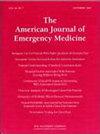Emergency medicine updates: Cardiac arrest airway management
IF 2.7
3区 医学
Q1 EMERGENCY MEDICINE
引用次数: 0
Abstract
Introduction
Cardiac arrest is the loss of systemic circulation. The approach to airway management is an important component of the resuscitation of patients in cardiac arrest.
Objective
This paper evaluates key evidence-based updates concerning airway management in cardiac arrest.
Discussion
Management of cardiac arrest focuses on cardiopulmonary resuscitation (CPR), including high-quality chest compressions and ventilation. Resuscitation should prioritize circulation with high-quality compressions, but as the resuscitation continues, airway management is necessary to provide ventilation. During initial CPR efforts, a compression to ventilation ratio of 30:2 is recommended. Bag-valve-mask (BVM) ventilation is an effective means of ventilation during CPR efforts, though providers should ensure appropriate mask seal with a two-person BVM strategy (one person holding the mask and one person ventilating) if possible. Breaths should be provided over less than 1 s with enough tidal volume to cause chest rise. Advanced airways include a supraglottic airway (SGA) or endotracheal tube via endotracheal intubation (ETI). If an advanced airway is present, one asynchronous ventilation should be provided every 8–10 s. An advanced airway may be considered with an asphyxial cause of arrest, those with prolonged arrest or transport, and cases managed with limited numbers of experienced personnel, though compressions must not be interrupted for placement of an advanced airway. An SGA is a viable option for an advanced airway. In settings with high ETI success rate, ETI may be performed, but in other settings SGA is recommended. If performing ETI, video laryngoscopy is associated with an improved view of the glottis and higher first pass success compared to direct laryngoscopy. Cricoid pressure is not recommended. Confirmation of ETI is necessary. Following ETI and return of spontaneous circulation, a lung protective strategy of ventilation is recommended while avoiding hypoxia.
Conclusions
An understanding of literature updates regarding airway management can improve the ED care of patients in cardiac arrest.
急诊医学更新:心脏骤停气道管理
心脏骤停是指体循环的丧失。气道管理方法是心脏骤停患者复苏的重要组成部分。目的评价心脏骤停患者气道管理的关键循证最新进展。心脏骤停的管理重点是心肺复苏(CPR),包括高质量的胸外按压和通气。复苏应优先考虑高质量的按压循环,但随着复苏的继续,气道管理是必要的,以提供通气。在最初的心肺复苏术中,建议按压与通气的比例为30:2。气囊-阀-面罩(BVM)通气是心肺复苏术中有效的通气手段,但如果可能,提供者应确保适当的面罩密封,采用两人BVM策略(一人拿口罩,一人通气)。呼吸的时间应少于15秒,并有足够的潮气量引起胸气上升。高级气道包括声门上气道(SGA)或经气管插管(ETI)的气管内插管。如有先进气道,应每8-10秒进行一次非同步通气。先进气道可考虑窒息性停搏原因,长时间停搏或转移,以及经验丰富的人员数量有限的病例,但不得中断压迫以放置先进气道。SGA是先进气道的可行选择。在ETI成功率高的情况下,可以进行ETI,其他情况下建议使用SGA。如果进行ETI,视频喉镜与声门的视野改善有关,与直接喉镜相比,第一次通过的成功率更高。不建议按压环状软骨。确认ETI是必要的。在ETI和自然循环恢复后,建议在避免缺氧的同时采取通气的肺保护策略。结论了解有关气道管理的最新文献可以提高心脏骤停患者的急诊护理水平。
本文章由计算机程序翻译,如有差异,请以英文原文为准。
求助全文
约1分钟内获得全文
求助全文
来源期刊
CiteScore
6.00
自引率
5.60%
发文量
730
审稿时长
42 days
期刊介绍:
A distinctive blend of practicality and scholarliness makes the American Journal of Emergency Medicine a key source for information on emergency medical care. Covering all activities concerned with emergency medicine, it is the journal to turn to for information to help increase the ability to understand, recognize and treat emergency conditions. Issues contain clinical articles, case reports, review articles, editorials, international notes, book reviews and more.

 求助内容:
求助内容: 应助结果提醒方式:
应助结果提醒方式:


